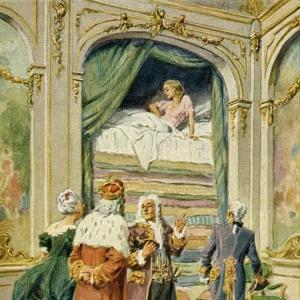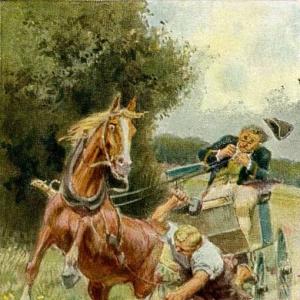Reading time: 16 min
In the forest, high up on the steep shore, and not far from the open seacoast, stood a very old oak-tree. It was just three hundred and sixty-five years old, but that long time was to the tree as the same number of days might be to us. We wake by day and sleep by night, and then we have our dreams. It is different with the tree. It is obliged to keep awake through three seasons of the year, and does not get any sleep till winter comes. Winter is its time for rest; its night after the long day of spring, summer, and autumn. On many a warm summer, the Ephemera, the flies that exist for only a day, had fluttered about the old oak, enjoyed life and felt happy and if, for a moment, one of the tiny creatures rested on one of his large fresh leaves, the tree would always say, „Poor little creature! your whole life consists only of a single day. How very short. It must be quite melancholy.“
„Melancholy! what do you mean?“ the little creature would always reply. „Everything around me is so wonderfully bright and warm, and beautiful, that it makes me joyous.“
„But only for one day, and then it is all over.“
„Over!“ repeated the fly; „what is the meaning of all over? Are you all over too?“
„No. I shall very likely live for thousands of your days, and my day is whole seasons long; indeed it is so long that you could never reckon it out.“
„No? then I don’t understand you. You may have thousands of my days, but I have thousands of moments in which I can be merry and happy. Does all the beauty of the world cease when you die?“
„No,“ replied the tree; „it will certainly last much longer,– infinitely longer than I can even think of.“ – „Well, then,“ said the little fly, „we have the same time to live; only we reckon differently.“ And the little creature danced and floated in the air, rejoicing in her delicate wings of gauze and velvet, rejoicing in the balmy breezes, laden with the fragrance of clover-fields and wild roses, elder-blossoms and honeysuckle, from the garden hedges, wild thyme, primroses, and mint, and the scent of all these was so strong that the perfume almost intoxicated the little fly. The long and beautiful day had been so full of joy and sweet delights, that when the sun sank low it felt tired of all its happiness and enjoyment. Its wings could sustain it no longer, and gently and slowly it glided down upon the soft waving blades of grass, nodded its little head as well as it could nod, and slept peacefully and sweetly. The fly was dead.
„Poor little Ephemera!“ said the oak; „what a terribly short life!“ And so, on every summer day the dance was repeated, the same questions asked, and the same answers given. The same thing was continued through many generations of Ephemera; all of them felt equally merry and equally happy.
The oak remained awake through the morning of spring, the noon of summer, and the evening of autumn; its time of rest, its night drew nigh– winter was coming. Already the storms were singing, „Good-night, good-night.“ Here fell a leaf and there fell a leaf. „We will rock you and lull you. Go to sleep, go to sleep. We will sing you to sleep, and shake you to sleep, and it will do your old twigs good. They will even crackle with pleasure. Sleep sweetly, sleep sweetly, it is your three-hundred-and-sixty-fifth night. Correctly speaking, you are but a youngster in the world. Sleep sweetly, the clouds will drop snow upon you, which will be quite a cover-lid, warm and sheltering to your feet. Sweet sleep to you, and pleasant dreams.“ And there stood the oak, stripped of all its leaves, left to rest during the whole of a long winter, and to dream many dreams of events that had happened in its life, as in the dreams of men. The great tree had once been small; indeed, in its cradle it had been an acorn. According to human computation, it was now in the fourth century of its existence. It was the largest and best tree in the forest. Its summit towered above all the other trees, and could be seen far out at sea, so that it served as a landmark to the sailors. It had no idea how many eyes looked eagerly for it. In its topmost branches the wood-pigeon built her nest, and the cuckoo carried out his usual vocal performances, and his well-known notes echoed amid the boughs; and in autumn, when the leaves looked like beaten copper plates, the birds of passage would come and rest upon the branches before taking their flight across the sea. But now it was winter, the tree stood leafless, so that every one could see how crooked and bent were the branches that sprang forth from the trunk. Crows and rooks came by turns and sat on them, and talked of the hard times which were beginning, and how difficult it was in winter to obtain food.
It was just about holy Christmas time that the tree dreamed a dream. The tree had, doubtless, a kind of feeling that the festive time had arrived, and in his dream fancied he heard the bells ringing from all the churches round, and yet it seemed to him to be a beautiful summer’s day, mild and warm. His mighty summits was crowned with spreading fresh green foliage. The sunbeams played among the leaves and branches, and the air was full of fragrance from herb and blossom; painted butterflies chased each other. The summer flies danced around him, as if the world had been created merely for them to dance and be merry in. All that had happened to the tree during every year of his life seemed to pass before him, as in a festive procession. He saw the knights of olden times and noble ladies ride by through the wood on their gallant steeds, with plumes waving in their hats, and falcons on their wrists. The hunting horn sounded, and the dogs barked. He saw hostile warriors, in colored dresses and glittering armor, with spear and halberd, pitching their tents, and anon striking them. The watchfires again blazed, and men sang and slept under the hospitable shelter of the tree. He saw lovers meet in quiet happiness near him in the moonshine, and carve the initials of their names in the grayish-green bark on his trunk. Once, but long years had intervened since then, guitars and Eolian harps had been hung on his boughs by merry travellers. Now they seemed to hang there again, and he could hear their marvellous tones. The wood-pigeons cooed as if to explain the feelings of the tree, and the cuckoo called out to tell him how many summer days he had yet to live. Then it seemed as if new life was thrilling through every fibre of root and stem and leaf, rising even to the highest branches. The tree felt itself stretching and spreading out, while through the root beneath the earth ran the warm vigor of life. As he grew higher and still higher, with increased strength, his topmost boughs became broader and fuller; and in proportion to his growth, so was his self-satisfaction increased, and with it arose a joyous longing to grow higher and higher, to reach even to the warm, bright sun itself. Already had his topmost branches pierced the clouds, which floated beneath them like troops of birds of passage, or large white swans; every leaf seemed gifted with sight, as if it possessed eyes to see. The stars became visible in broad daylight, large and sparkling, like clear and gentle eyes. They recalled to the memory the well-known look in the eyes of a child, or in the eyes of lovers who had once met beneath the branches of the old oak. These were wonderful and happy moments for the old tree, full of peace and joy; and yet, amidst all this happiness, the tree felt a yearning, longing desire that all the other trees, bushes, herbs, and flowers beneath him, might be able also to rise higher, as he had done, and to see all this splendor, and experience the same happiness. The grand, majestic oak could not be quite happy in the midst of his enjoyment, while all the rest, both great and small, were not with him. And this feeling of yearning trembled through every branch, through every leaf, as warmly and fervently as if they had been the fibres of a human heart. The summit of the tree waved to and fro, and bent downwards as if in his silent longing he sought for something. Then there came to him the fragrance of thyme, followed by the more powerful scent of honeysuckle and violets; and he fancied he heard the note of the cuckoo. At length his longing was satisfied. Up through the clouds came the green summits of the forest trees, and beneath him, the oak saw them rising, and growing higher and higher. Bush and herb shot upward, and some even tore themselves up by the roots to rise more quickly. The birch-tree was the quickest of all. Like a lightning flash the slender stem shot upwards in a zigzag line, the branches spreading around it like green gauze and banners. Every native of the wood, even to the brown and feathery rushes, grew with the rest, while the birds ascended with the melody of song. On a blade of grass, that fluttered in the air like a long, green ribbon, sat a grasshopper, cleaning his wings with his legs. May beetles hummed, the bees murmured, the birds sang, each in his own way. The air was filled with the sounds of song and gladness.
„But where is the little blue flower that grows by the water?“ asked the oak, „and the purple bell-flower, and the daisy?“ You see the oak wanted to have them all with him.
„Here we are, we are here,“ sounded in voice and song.
„But the beautiful thyme of last summer, where is that? and the lilies-of-the-valley, which last year covered the earth with their bloom? and the wild apple-tree with its lovely blossoms, and all the glory of the wood, which has flourished year after year? even what may have but now sprouted forth could be with us here.“
„We are here, we are here,“ sounded voices higher in the air, as if they had flown there beforehand.
„Why this is beautiful, too beautiful to be believed,“ said the oak in a joyful tone. „I have them all here, both great and small. Not one has been forgotten. Can such happiness be imagined?“ It seemed almost impossible.
„In heaven with the Eternal God, it can be imagined, and it is possible,“ sounded the reply through the air.
And the old tree, as it still grew upwards and onwards, felt that his roots were loosening themselves from the earth.
„It is right so, it is best,“ said the tree, „no fetters hold me now. I can fly up to the very highest point in light and glory. And all I love are with me, both small and great. All– all are here.“
Such was the dream of the old oak: and while he dreamed, a mighty storm came rushing over land and sea, at the holy Christmas time. The sea rolled in great billows towards the shore. There was a cracking and crushing heard in the tree. The root was torn from the ground just at the moment when in his dream he fancied it was being loosened from the earth. He fell– his three hundred and sixty-five years were passed as the single day of the Ephemera. On the morning of Christmas-day, when the sun rose, the storm had ceased. From all the churches sounded the festive bells, and from every hearth, even of the smallest hut, rose the smoke into the blue sky, like the smoke from the festive thank-offerings on the Druids‘ altars. The sea gradually became calm, and on board a great ship that had withstood the tempest during the night, all the flags were displayed, as a token of joy and festivity. „The tree is down! The old oak,– our landmark on the coast!“ exclaimed the sailors. „It must have fallen in the storm of last night. Who can replace it? Alas! no one.“ This was a funeral oration over the old tree; short, but well-meant. There it lay stretched on the snow-covered shore, and over it sounded the notes of a song from the ship– a song of Christmas joy, and of the redemption of the soul of man, and of eternal life through Christ’s atoning blood.
„Sing aloud on the happy morn,
All is fulfilled, for Christ is born;
With songs of joy let us loudly sing,
‚Hallelujahs to Christ our King.'“
Thus sounded the old Christmas carol, and every one on board the ship felt his thoughts elevated, through the song and the prayer, even as the old tree had felt lifted up in its last, its beautiful dream on that Christmas morn.
 Learn languages. Double-tap on a word.Learn languages in context with Childstories.org and Deepl.com.
Learn languages. Double-tap on a word.Learn languages in context with Childstories.org and Deepl.com.Backgrounds
Interpretations
Adaptions
Summary
Linguistics
„The Last Dream of the Old Oak“ is a fairy tale by Danish author Hans Christian Andersen. Born on April 2, 1805, in Odense, Denmark, Andersen is one of the most famous and influential authors of children’s literature. He was a prolific writer who produced plays, novels, travelogues, and autobiographies, but he is best known for his fairy tales, which have been translated into more than 125 languages.
Andersen’s fairy tales often feature elements of magic and fantasy, exploring themes such as love, morality, friendship, and the power of imagination. Some of his most famous works include „The Little Mermaid,“ „The Ugly Duckling,“ „The Emperor’s New Clothes,“ and „The Snow Queen.“
„The Last Dream of the Old Oak“ was first published in 1858 as part of Andersen’s collection of fairy tales titled „New Fairy Tales. Second Volume. 1858.“ This collection included three other stories: „The Bell,“ „The Goblin and the Grocer,“ and „The Candles.“
In „The Last Dream of the Old Oak,“ Andersen weaves a tale that combines elements of fantasy, nature, and spirituality to explore themes such as the passage of time, interconnectedness, and the meaning of life. This story reflects Andersen’s ability to create thought-provoking narratives that resonate with readers of all ages, transcending the boundaries of time and culture.
„The Last Dream of the Old Oak“ by Hans Christian Andersen can be interpreted on multiple levels, touching on themes such as the passage of time, the meaning of life, interconnectedness, and spiritual growth.
Passage of time and the meaning of life: The conversation between the oak tree and the Ephemera fly highlights the contrast between their lifespans, with the fly living only a day and the oak for centuries. However, the fly points out that they both enjoy the beauty of the world during their respective lives, suggesting that the quality of one’s life is not solely determined by its length, but rather by the experiences and joy it brings.
Interconnectedness: The oak tree’s dream emphasizes the importance of interconnectedness among all living beings. The oak tree experiences true happiness only when it is able to share its joy and growth with other trees, plants, and creatures in the forest. This theme illustrates the idea that happiness and fulfillment come from relationships and connections with others, not from individual achievements or material gains.
Spiritual growth: The oak tree’s dream of reaching towards the sun and eventually breaking free from earthly bounds can be seen as a metaphor for spiritual growth and the pursuit of higher understanding. The tree’s realization that such happiness can only be found in heaven with the Eternal God suggests that true contentment and peace come from a connection with a higher power or spiritual realm.
Hope and redemption: The story takes place during the Christmas season, a time of hope, renewal, and the celebration of Christ’s birth. The Christmas carol sung by the sailors symbolizes the message of hope and redemption, which resonates with the oak tree’s dream of transcending its earthly existence and experiencing a higher state of being.
Overall, „The Last Dream of the Old Oak“ encourages reflection on the value of life, the importance of connections with others, and the pursuit of spiritual growth and enlightenment.
„The Last Dream of the Old Oak“ has inspired a number of adaptations and retellings in various forms of media. Here are a few examples.
Illustrations: The story has been illustrated by various artists, including Vilhelm Pedersen, the original illustrator of many of Andersen’s fairy tales. Other illustrators include Arthur Rackham, Kay Nielsen, and Edmund Dulac.
Ballet: Russian composer Reinhold Glière created a ballet adaptation of the story in 1922, which was later revised by Soviet choreographer Leonid Lavrovsky in 1957.
Animated adaptations: The story has been adapted into animated films by several studios, including Soyuzmultfilm in Russia and Brøderbund Software in the United States.
Children’s books: „The Last Dream of the Old Oak“ has been adapted into a number of children’s books, including „The Old Oak Tree’s Last Dream“ by Laura Lee Benson and „The Last Dream of the Old Oak Tree“ by Hans Christian Andersen and Susan Pearson.
Theater: The story has also been adapted for the stage, including a production by the Royal Danish Ballet in 2015.
Overall, „The Last Dream of the Old Oak“ continues to inspire artists and storytellers around the world, and its themes of nature, tradition, and renewal remain as relevant today as they were when the story was first written.
„The Last Dream of the Old Oak“ by Hans Christian Andersen tells the story of a 365-year-old oak tree that stands on a steep shore near the open sea. The tree has a conversation with a short-lived Ephemera fly and ponders the brevity of its life. The oak witnesses various events in its long life, serving as a landmark for sailors and a resting place for lovers and travelers.
During winter, the oak tree goes into a deep sleep and dreams. In its dream, the oak experiences the joy of growing taller and higher, reaching the warm sun. It longs for other trees, bushes, and flowers to share this blissful experience. Miraculously, all the trees and plants from the forest grow taller, joining the oak in its ascent.
The dream continues with the oak tree feeling immense happiness, as it is surrounded by all the plants and creatures it loves. The tree realizes that such joy can only be imagined in heaven with the Eternal God. In the dream, the oak tree’s roots loosen from the earth, enabling it to fly higher with everything it loves.
As the oak tree dreams, a mighty storm comes over the land and sea during the holy Christmas time. The storm uproots the oak tree, ending its life. On Christmas morning, the sun rises, and a ship displays its flags in celebration. The sailors mourn the loss of the oak tree, acknowledging its importance as a landmark.
A Christmas carol is sung from the ship, celebrating the joy and redemption brought by Christ’s birth. The song represents the uplifting feeling that the oak tree experienced in its last beautiful dream.
The fairy tale „The Last Dream of the Old Oak“ by Hans Christian Andersen employs rich linguistic and thematic elements that impart both a sense of time and a meditation on the nature of life and death.
Personification: Andersen personifies the old oak tree, giving it human-like characteristics such as the ability to dream, feel happiness, and yearn. This personification allows readers to empathize with the oak and perceive it as a sentient being with a life cycle comparable to that of humans.
Temporal Framework: The story juxtaposes two very different perceptions of time. The oak’s life spans centuries, while the ephemeral flies live for a single day. Andersen uses this contrast to explore the relativity of life and time, highlighting that fulfillment and happiness depend more on perception than on duration.
Dialogue: The conversations between the oak and the Ephemera reveal different existential perspectives. The oak initially views the fly’s life as tragically short, while the Ephemera sees beauty and joy in its fleeting existence. Through this dialogue, Andersen suggests that contentment is subjective and dependent on one’s outlook on life, irrespective of its length.
Imagery and Sensory Details: Andersen enriches the narrative with vivid imagery and sensory descriptions, especially in the portrayal of nature. The scents of clover-fields, the sight of painted butterflies, and the sounds of the cuckoo, all create an immersive atmosphere that reflects the vibrancy of the natural world. This imagery enhances the theme of life’s beauty and the interconnectedness of living things.
Symbolism: The oak tree symbolizes strength, longevity, and stability, serving as a landmark for sailors. Its eventual fall during a Christmas storm symbolizes the natural cycle of life and death. The timing of the dream and the tree’s fall during Christmas underscores themes of redemption, renewal, and the spiritual continuity of life.
Contrasts and Juxtapositions: Andersen contrasts the ephemeral and the eternal, the microcosm of a single day, and the macrocosm of centuries. Through these contrasts, he encourages readers to ponder profound questions about the nature of existence, mortality, and the potential for continuity beyond physical life.
Metaphorical Language: Metaphors are used to convey complex ideas simply and poetically. For instance, the oak’s desire for other trees and plants to rise as it does symbolizes a longing for communal elevation and unity.
Narrative Structure and Tone: The fairy tale’s structure is cyclical, beginning with the oak’s awareness of its age and ending with its culmination in death, mirroring the natural cycle of life. The tone is reflective and serene, encouraging contemplation and acceptance of life’s transience.
In summary, „The Last Dream of the Old Oak“ blends linguistic devices and thematic richness to explore the essence of life, time, and death. Through personification, dialogue, vivid imagery, and metaphorical language, Andersen crafts a tale that resonates on both philosophical and emotional levels, inviting readers to reflect on the relative value of their own lives.
Information for scientific analysis
Fairy tale statistics | Value |
|---|---|
| Translations | EN, DA, ES, FR, IT, NL |
| Readability Index by Björnsson | 31.2 |
| Flesch-Reading-Ease Index | 79.2 |
| Flesch–Kincaid Grade-Level | 6.6 |
| Gunning Fog Index | 9.1 |
| Coleman–Liau Index | 9 |
| SMOG Index | 8.8 |
| Automated Readability Index | 7.2 |
| Character Count | 12.215 |
| Letter Count | 9.493 |
| Sentence Count | 128 |
| Word Count | 2.255 |
| Average Words per Sentence | 17,62 |
| Words with more than 6 letters | 306 |
| Percentage of long words | 13.6% |
| Number of Syllables | 2.926 |
| Average Syllables per Word | 1,30 |
| Words with three Syllables | 121 |
| Percentage Words with three Syllables | 5.4% |

 Facebook
Facebook  Whatsapp
Whatsapp  Messenger
Messenger  Telegram
Telegram Reddit
Reddit














